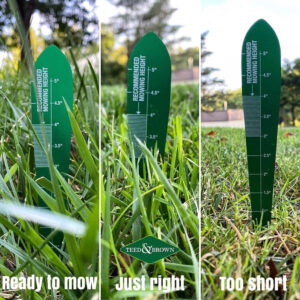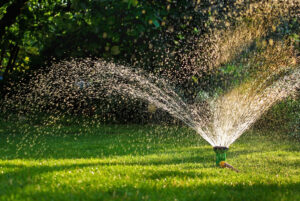Weather Report
summer Season 2025
Your Summer Oasis: The Ultimate Summer Guide for Your Lawn.
It’s finally that time of year. The sun is out, the birds are chirping, and you are creating memories on your Teed & Brown lawn.

What are we seeing in the Connecticut, New York and New Jersey area? (Updated weekly)
Who turned on the heat?! We’re right in the middle of a full-blown heat wave, and unfortunately, our grasses aren’t fans of this kind of weather. Here in the Northeast, we grow cool-season grasses—emphasis on cool. This hot, humid stretch feels more like the subtropics, and once temperatures climb above 85°F, our turf really starts to feel the stress. Add in high humidity, and disease pressure skyrockets.
That said, most lawns are holding up fairly well, but we are starting to see a variety of issues—mainly related to water. Areas with sandy or shallow soil (often due to ledge or rock underneath) are drying out quickly. On the flip side, lawns with poor drainage or too much water are beginning to show signs of disease.
The best advice for now: keep your watering consistent. Don’t increase it just yet—try to stick to your usual routine until this weather breaks. It’s all about getting through this stretch with minimal stress to your lawn.
What’s the one thing you should not do to your lawn in the summer?
Click here to find out: https://youtu.be/HTJOUuCv0Hw
What happens to lawns during the summer?
During the summer, your lawn undergoes various changes and faces specific challenges due to the hot and dry weather conditions. Here are some key points on what happens to your lawn during this season:
- GROWTH: Many types of grasses experience their peak growth during the summer. Adequate sunlight and warm temperatures promote the rapid development of grass blades, leading to a thick and vibrant appearance.
- WATERING NEEDS: The increased temperatures and higher evaporation rates cause moisture loss from the soil, making watering crucial. Lawns generally require more frequent and deeper watering to ensure they receive sufficient hydration. Watering early in the morning helps minimize evaporation.
- BROWN PATCHES: Despite regular watering, certain grass species may still develop brown or dry patches during intense heatwaves. This can occur due to inadequate irrigation or underlying soil issues. Identifying and addressing these problems promptly can help maintain a healthy lawn.
- STRESS AND DORMANCY: Extended periods of high temperatures and limited rainfall can cause stress to grass. In response, some types of grasses may enter a dormant state to conserve energy and survive harsh conditions. This dormancy can result in a brown or straw-like appearance. Once cooler temperatures and moisture return, the grass will typically recover.
- WEED GROWTH: Weeds are opportunistic plants that thrive under stressful conditions. They can take advantage of weakened or damaged grass to invade your lawn during the summer. Regular maintenance, such as mowing at the correct height and applying appropriate weed control measures, can help keep weeds in check.
- PESTS AND DISEASES: Certain pests and diseases are more prevalent during the summer months. Insects like grubs, chinch bugs, and armyworms can cause damage to the grass, while diseases like brown patch or dollar spot may develop under hot and humid conditions. Regular monitoring and appropriate treatment can help prevent or mitigate such issues.
To maintain a healthy summer lawn, it is essential to follow proper watering and mowing practices, we’ll do the rest.
Mowing Tips:
- SHARPEN THE MOWER BLADES!
We can’t stress enough how important this is. Sharp blades are critical for plant health. - IT’S OKAY TO LEAVE THE CLIPPINGS!
The grass clippings will provide and return vital nutrients to the soil. There’s no benefit to taking those away. - LONGER IS BETTER!
Mowing your lawn between 3 and 3 1/2 inches long has proven to be ideal for healthy grass in a home lawn.
Understand the importance of these steps a little further with Christopher Brown by clicking on the link: https://youtu.be/EqR837mg318

Watering your Lawn in the Summer
Click on the link to watch Christopher Brown as he walks you through how to water your lawn in the summer: https://youtu.be/p_o0XoOgxlw
Watering your lawn properly during the summer is crucial to keep it healthy and vibrant. Here are some tips for watering your lawn during this season:
- WATER DEEPLY: Instead of frequent shallow watering, it’s better to water your lawn deeply and infrequently. This encourages the roots to grow deeper, making the grass more resilient to drought conditions. Aim for about 1 inch of water per week, including rainfall.
- TIME IT RIGHT: Water your lawn early in the morning when temperatures are cooler. This reduces water loss due to evaporation and allows the grass to absorb moisture effectively.
- AVOID OVERWATERING: While it’s important to provide enough water, overwatering can be detrimental to your lawn. Excessive moisture can lead to shallow root growth, increased vulnerability to diseases, and the growth of weeds. Ensure the water penetrates the soil, but avoid creating puddles or runoff.
- USE PROPER IRRIGATION TECHNIQUES: If you use a sprinkler system, make sure it delivers water evenly across the lawn. Adjust sprinkler heads to avoid wasteful overspray onto hardscapes or areas that don’t require watering. Consider using a soaker hose or drip irrigation system for more targeted and efficient watering.
- OBSERVE THE SIGNS: Keep an eye on your lawn for signs of water stress. If the grass blades start to turn a dull grayish-blue color or footprints remain visible for an extended period, it’s an indication that your lawn needs watering.
- WATER CONSERVATION: During periods of water restrictions or drought conditions, it’s essential to prioritize water conservation. Follow any guidelines or restrictions provided by local authorities and adjust your watering schedule accordingly. Consider using recycled or harvested water sources, such as rainwater, when possible.

Why is your lawn turning brown, even with plenty of water and fertilizer?
It might not be a surface problem… it could be rock ledge just below your grass.
In this video, Chris breaks down how ledge creates dry, overheated soil and weak roots—especially during summer. Learn what you can do to build a healthier lawn long-term.
📍 Watch now to find out if ledge is hiding under your lawn!
https://youtu.be/2okBvdBXiko?si=3zHiqmoYUkQgndpK
